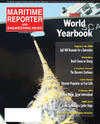
Page 52: of Maritime Reporter Magazine (June 2, 2010)
Read this page in Pdf, Flash or Html5 edition of June 2, 2010 Maritime Reporter Magazine
It will never happen to me!
Isn’t that belief lurking somewhere in the consciousness of every mariner? Isn’t it, in fact, most deeply rooted in the minds of the most qualified and experi- enced among us?
For those with long years at sea, the proximity of danger becomes routine, and that’s a danger in itself. It’s easy to begin to regard oneself as too competent and too capable. Drills and training?
They’re important for the junior members of the crew, but the old salts know it all by heart. They’ve got better thing to do.
Captain Dave Shoemaker believed it couldn’t happen to him. He had 28 years under his belt as skipper of the big crab- bers and catcher processors that work the
Bering Sea. Of course, the fishing indus- try is uniquely dangerous. The Seattle- based distant water fleet that dominates the offshore harvests in Alaska works year-round on one of the world’s toughest oceans. While most vessels load their car- gos at the dock, fishermen open their hatches in mid ocean and as product fills the fish hold, the fuel and stores dimin- ish. Stability is a major challenge, and in today’s industrial fisheries, along with all of the traditional responsibilities of sea- manship, the captains have crews of min- imally trained processing workers to contend with.
Big challenges didn’t intimidate Shoe- maker. The ex-marine and devout Chris- tian was supremely confident in his own abilities. In a quarter century at the helm, he’d never suffered a major casualty.
From the beginning, he had been fortu- nate to work for some of the best opera- tors in the business, owners whose boats were referred to as Northwest Cadillacs, locally built and regarded as ideally suited for Alaskan waters.
The 190-foot Galaxy was the biggest freezer-longliner in the Alaska fleet when
Shoemaker took the helm in 1998 after a major conversion. He immediately lob- bied the owner to have her certificated as in class by the American Bureau of Ship- ping, although they were under no legal requirement to do so, and the vessel was awarded Maltese Cross certification.
I said, if we’re going to take a vessel of this size and we’re going to go out there and we’re going to make a splash with
Aleutian Spray Fisheries getting involved in the hook and line industry with the biggest hook and line boat that’s been put on the water, let’s do it right, and he said,
I totally agree with you. In that respect, a lot of conscious effort went into having all of the proper equipment, safety pro- cedures, backup equipment, all of the things that a lot of vessels won’t do be- cause it’s costly.
Still, he admits that the fishing industry as a whole was lax in meeting its legal and moral requirements to undertake reg- ular onboard drills and training. Nobody trained on the cod grounds because it cut into fishing time, he says, and when you’re transiting to the grounds you’re sleeping because you just offloaded, and when you’re transiting back from the grounds to town, you’re sleeping because you just spent several days working your heart out to fill up that boat.
Rather, Shoemaker relied on his own skill and experience and the qualifica- tions of his key officers to ensure the safety the vessel and its 26-member crew.
The Galaxy was proceeding at 11 knots on a heading of 270 degrees approxi- mately 30 to 35 miles Southwest of St.
Paul Island in the Pribilofs on her way to retrieve longline gear on the afternoon of
October 20, 2002. The wind was out of the North-Northeast at 20 to 30 knots and the seas were 15 to 20 feet. The air tem- perature was 35 degrees F., and the water temperature was 43 degrees F.
It was no different than any other com- mute, Shoemaker says. We were in the trough, in the ditch, we were running back up to the NW and we took a wave on the starboard stern quarter. I remem- ber it specifically because we were hav- ing a meal at that time and I remember thinking about the cook being really mad, really angry because it probably shifted everything in the galley.
Nobody will ever know for sure, but perhaps the impact of the wave disrupted more than the galley. At approximately 1622 local time, crewmembers sighted smoke on multiple decks. Shoemaker was in the wheelhouse when a process- ing foreman rushed in and advised him there was smoke in the fish factory.
What kind of smoke, the captain de- manded? What did it look like?
Like that smoke behind you, was the reply and Shoemaker turned to see thick black smoke corkscrewing out of corner joints in the fidley. Shoemaker’s mind 52 Maritime Reporter & Engineering News 2010 WORLD YEARBOOK TRAINING & EDUCATION
Lessons Learned from the Galaxy
Tragedy & Courage on the Bering Sea
Last sighting of the F/V Galaxy on October 21, the day after the fire and explo- sions.
Captain Shoemaker is awarded the
U.S. Coast Guard’s Gold Medal Life
Saving Award.
The crew of U.S. Coast Guard helicop- ter CG6021 which responded to the casualty.
The burning F/V Galaxy. Captain Shoemaker and two crewmembers, visible on the bow in their immersion suits.

 51
51

 53
53
